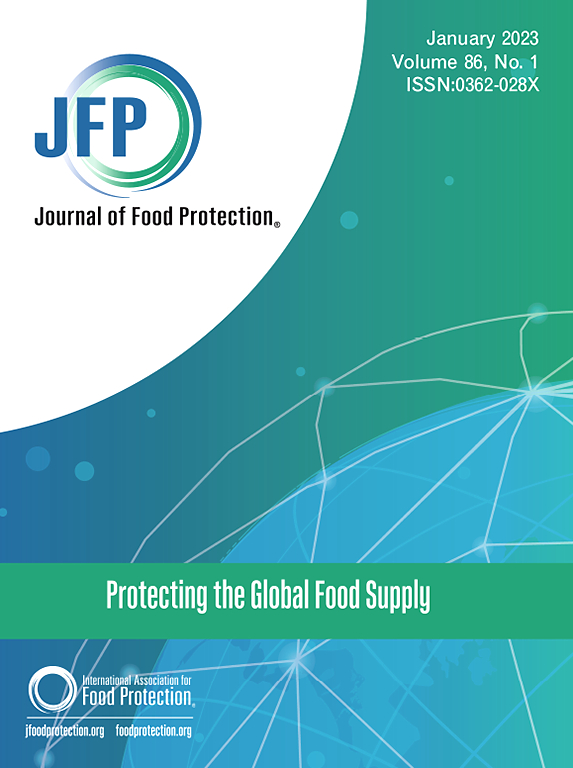Comparison of Food Safety Hazards in Pigs and Broilers from Intensive and Extensive Production Systems: A Literature Review
IF 2.1
4区 农林科学
Q3 BIOTECHNOLOGY & APPLIED MICROBIOLOGY
引用次数: 0
Abstract
Consumer demand for meat from extensive production (e.g., organic, free-range, and antimicrobial-free) is increasing, partly due to consumers’ perception that these types are safer than conventional meats. This review compared food safety hazards (namely, zoonotic parasites, bacterial pathogens, antimicrobial resistance, and chemical hazards) from pigs and broilers raised in intensive and extensive systems in Northern and Western European countries and the United States. Our findings showed that hazard occurrence between livestock production systems varied depending on the hazard. Pigs and broilers from extensive systems showed a higher prevalence of Toxoplasma gondii. Pathogen prevalence in pigs did not appear to be affected by production systems, while no clear conclusion could be drawn for broilers due to conflicting findings. Higher antimicrobial resistance (AMR) prevalence was common in pig and broiler samples from intensive farming, although samples from extensive farming were not free of AMR either. Studies on chemical hazards were limited, showing generally low contaminant levels in both production systems, including persistent organic pollutants, heavy metals, mycotoxins, pesticide residues, and antimicrobial residues. Therefore, more studies on chemical hazards are recommended to fill this data gap. Various factors associated with specific production systems could influence hazard prevalence, e.g., indoor confinement, outdoor access, antimicrobial policy, and slaughtering age. Regardless of the production system, other factors, such as seasonal variation and biosecurity levels, were also important.
集约型和粗放型生产系统中生猪和肉鸡的食品安全危害比较:文献综述。
消费者对粗放生产肉类(如有机肉、散养肉和无抗菌素肉)的需求正在增加,部分原因是消费者认为这些肉类比传统肉类更安全。这篇综述比较了北欧、西欧国家和美国集约化和粗放化饲养系统中饲养的猪和肉鸡的食品安全危害(即人畜共患病寄生虫、细菌病原体、抗菌素耐药性和化学危害)。我们的研究结果表明,不同畜牧生产系统之间发生的危害因危害的不同而各异。来自粗放型养殖系统的猪和肉鸡的弓形虫感染率较高。猪的病原体感染率似乎不受生产系统的影响,而肉鸡的病原体感染率则因研究结果相互矛盾而无法得出明确结论。在集约化养殖的猪和肉鸡样本中,抗菌素耐药性(AMR)普遍较高,尽管粗放型养殖的样本中也不乏抗菌素耐药性样本。对化学危害的研究有限,显示两种生产系统的污染物水平普遍较低,包括持久性有机污染物、重金属、霉菌毒素、农药残留和抗菌剂残留。因此,建议对化学危害进行更多研究,以填补这一数据空白。与特定生产系统相关的各种因素都可能影响危害的发生率,例如室内圈养、户外活动、抗菌药政策和屠宰年龄。无论生产系统如何,季节变化和生物安全水平等其他因素也很重要。
本文章由计算机程序翻译,如有差异,请以英文原文为准。
求助全文
约1分钟内获得全文
求助全文
来源期刊

Journal of food protection
工程技术-生物工程与应用微生物
CiteScore
4.20
自引率
5.00%
发文量
296
审稿时长
2.5 months
期刊介绍:
The Journal of Food Protection® (JFP) is an international, monthly scientific journal in the English language published by the International Association for Food Protection (IAFP). JFP publishes research and review articles on all aspects of food protection and safety. Major emphases of JFP are placed on studies dealing with:
Tracking, detecting (including traditional, molecular, and real-time), inactivating, and controlling food-related hazards, including microorganisms (including antibiotic resistance), microbial (mycotoxins, seafood toxins) and non-microbial toxins (heavy metals, pesticides, veterinary drug residues, migrants from food packaging, and processing contaminants), allergens and pests (insects, rodents) in human food, pet food and animal feed throughout the food chain;
Microbiological food quality and traditional/novel methods to assay microbiological food quality;
Prevention of food-related hazards and food spoilage through food preservatives and thermal/non-thermal processes, including process validation;
Food fermentations and food-related probiotics;
Safe food handling practices during pre-harvest, harvest, post-harvest, distribution and consumption, including food safety education for retailers, foodservice, and consumers;
Risk assessments for food-related hazards;
Economic impact of food-related hazards, foodborne illness, food loss, food spoilage, and adulterated foods;
Food fraud, food authentication, food defense, and foodborne disease outbreak investigations.
 求助内容:
求助内容: 应助结果提醒方式:
应助结果提醒方式:


